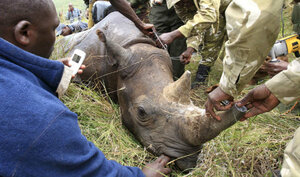To stop elephant and rhino poachers, dissuade buyers in China and Vietnam
Elephant and rhino populations in Africa are being decimated for ivory and rhino horn. In a vicious cycle, buyers in China and Vietnam fund terrorists in Africa who rely on crime groups and poachers. A social media campaign in Asia must make buying these products abhorrent.

Kenya Wildlife Service wardens insert a transmitter on a tranquilized male black rhinoceros for translocation at the Lake Nakuru National in 2010. Op-ed contributor Keith Martin writes that 'rhino horn is made of keratin, the same substance as fingernails, and has absolutely no medicinal power.'
Thomas Mukoya/Reuters/file
Wasington
President Obama’s announcement last month that the United States will contribute $10 million to combat rhinoceros and elephant poaching in Africa comes at a crucial time to address an ecological catastrophe.
In 2012, a shocking 30,000 elephants in Africa were slaughtered for their ivory, 7.4 percent of the entire population. Rhinos are in an even more precarious situation. Last year in South Africa, the last bastion for these species, 668 rhino were killed for their horns. This year, as of July 31, 536 rhino have been poached in South Africa. This is out of a global population of fewer than 30,000 rhinos, compared to 500,000 in Africa and Asia at the start of the 20th century.
Why is this important?
Terrorist organizations like Al Shabaab and the Lord’s Resistance Army, and militant groups from Africa’s Sahel to Somalia, are slaughtering elephants and rhinos to fund their violent activities. International crime syndicates, acting as middlemen, earn hundreds of millions of dollars trafficking in ivory and rhino horn. Purchasing these products enables these groups to have the funds to be a persistent threat to global security.
For countries like Tanzania, Kenya, and South Africa, home to these charismatic species, their existence fuels an ecotourism industry that generates millions of jobs and billions of dollars in foreign exchange. Wipe out these animals, and the tourists who come to see them will vanish. Jobs and futures will follow suit and many people will be tossed into a life of grinding poverty.
Outside Africa it is not well known that the fight to protect these animals has been a bloody, low-level war pitting lightly armed wildlife officers against heavily armed poachers. In this battle, a terrible toll has been paid by those who safeguard these animals. Poachers have murdered hundreds of game rangers in the last few years.
What can be done to stop the carnage?
Although enforcement efforts have improved, game rangers need better weaponry, drones to monitor large reserves, helicopters for rapid reaction capabilities, and night-vision goggles to give them a fighting chance against these well-armed poachers.
However, the best opportunity to stop the killing lies in collapsing demand for ivory and rhino horn in China and Vietnam, countries that are the consumer epicenter for these products. Without doing this, no matter how much is done to enhance anti-poaching activities, the financial incentive to kill these animals is just too great. Ivory is worth more than $1,000 per pound and rhino horn is more valuable than gold.
Alarmingly, organizations like the World Wildlife Fund’s TRAFFIC, which are devoted to stopping the illegal trade in wildlife products, have shown that a significant number of China’s burgeoning middle class of more than 230 million people have expressed a desire to purchase ivory. This is as much for personal pleasure as it is a demonstration of wealth.
Buying rhino horn has also become a status symbol. In Vietnam in particular, the rich buy it supposedly to ward off hangovers but mostly to show off their affluence. Others purchase it because they heard that an unnamed Vietnamese politician consumed rhino horn and was cured of an unnamed cancer. This is a cruel urban myth as rhino horn is made of keratin, the same substance as fingernails, and has absolutely no medicinal power.
To reduce demand, people’s behavior must change. A clear connection must be made between purchasing these products and the agony animals endure, the murder of brave conservation officers, and the terrorism threat.
Messages cannot be banal. They must appeal to people’s hearts as well as their minds. Videos and photos showing the situation on the ground should be distributed widely through the Internet. Savvy social networkers in China and Vietnam can do this. The ultimate goal must be to make it culturally and socially abhorrent to buy ivory or rhino horn.
The US contribution to save these species from extinction should certainly be used to provide better equipment for anti-poaching activities, but it must also support a grassroots social networking effort to spread visuals of the horrible cost paid by people, animals, and nations as a consequence of purchasing trinkets made of ivory and powders from rhino horn that have no medicinal value.
If this effort fails, elephants and rhinos, which have roamed this planet for tens of millions of years, will have but a decade left on Earth. Their very survival lies in the hands of the people of China and Vietnam who are thinking of buying ivory or rhino horn.
Dr. Keith Martin is the executive director for the Consortium of Universities for Global Health in Washington, D.C. He is a physician with extensive experience in conservation in Africa. He was a six-term member of Parliament in Canada and founded Canada’s first International Conservation Caucus.

